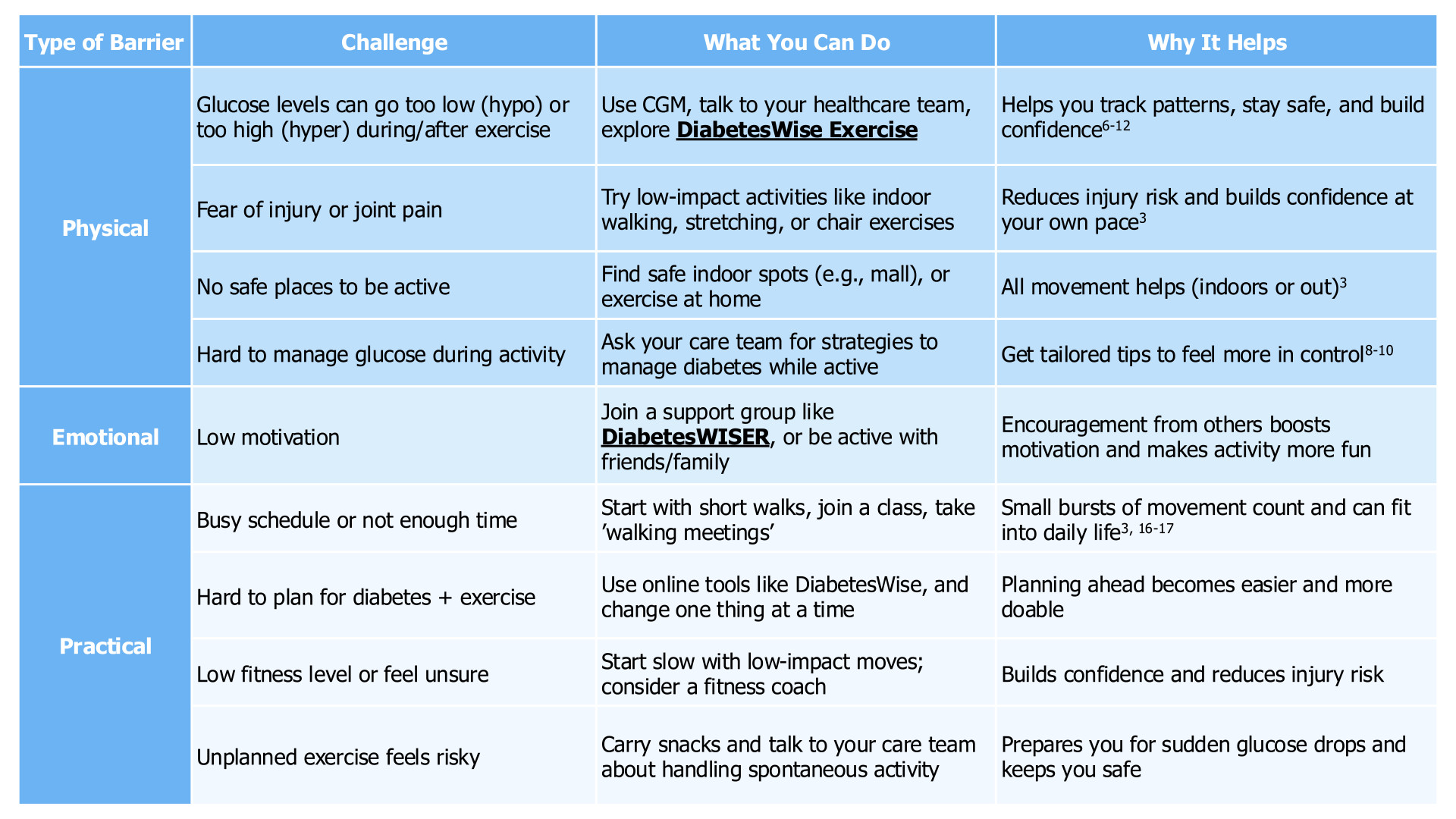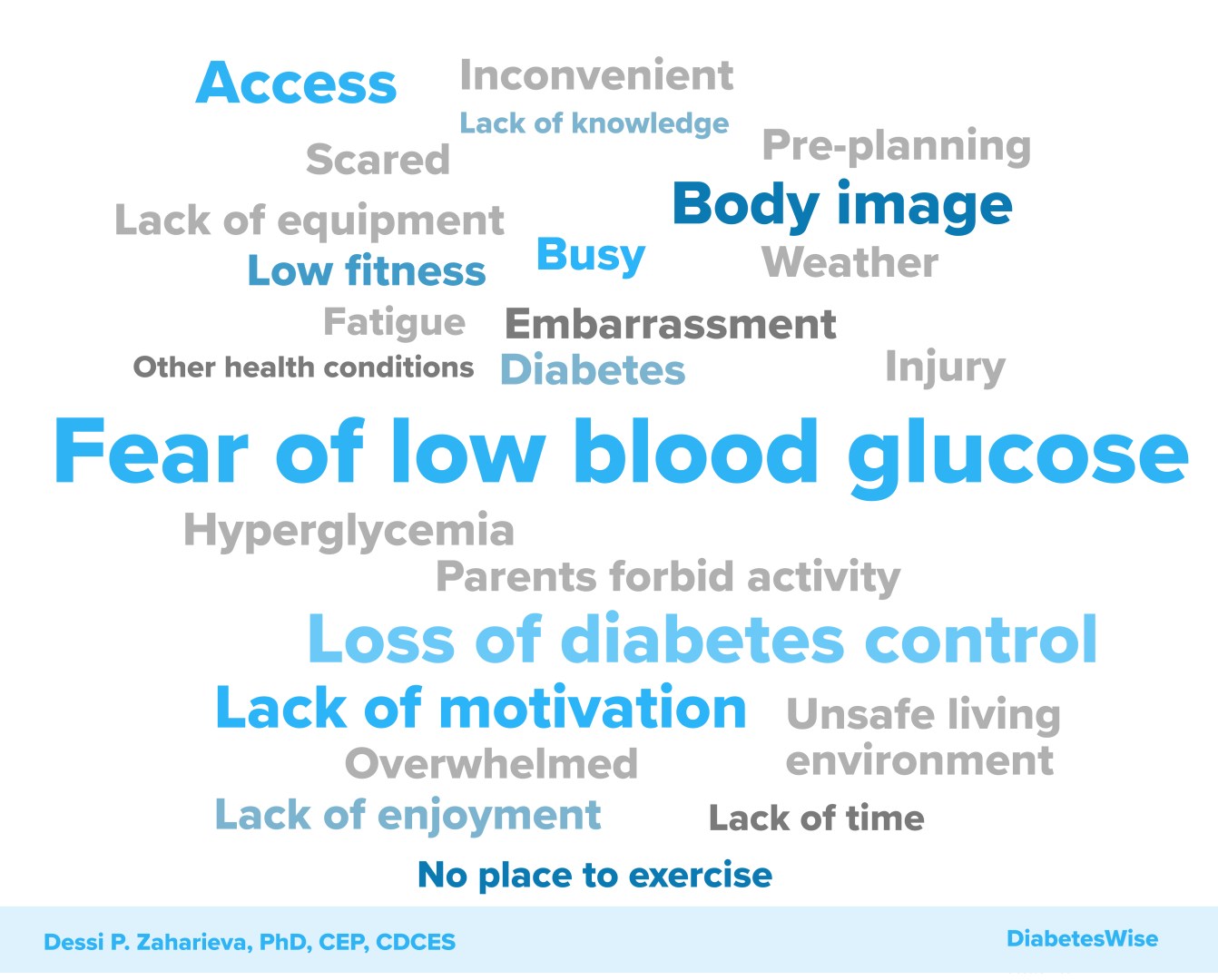Why do some people with diabetes worry about exercise?
People with diabetes often worry about exercising because of the increased risk of low glucose levels (hypoglycemia) during activity. This is one of the most common fears for both youth and adults with diabetes1–5. When glucose levels drop too low during or after physical activity, it can feel uncomfortable.
In fact, people who have had severe low blood glucose episodes during exercise in the past year are more likely to avoid exercise1. The table below shows common barriers that people with diabetes face when it comes to exercise, and strategies to help manage them. We want people to feel more confident with managing their diabetes and enjoying the benefits of regular exercise!

Most Common Barriers to Exercise
In the visual below, the bigger the word, the more that people mentioned it being a barrier to exercise1–4. This visual helps show what people with diabetes are generally most concerned about when it comes to being active. Everyone’s experiences are different, and every barrier is valid5,6,11,17,19.

Références
1. Brazeau AS, Rabasa-Lhoret R, Strychar I, Mircescu H. Barriers to physical activity among patients with type 1 diabetes. Diabetes Care. 2008;31(11):2108-2109. doi:10.2337/dc08-0720
2. Roberts AJ, Taplin CE, Isom S, et al. Association between fear of hypoglycemia and physical activity in youth with type 1 diabetes: The SEARCH for diabetes in youth study. Pediatr Diabetes. 2020;21(7):1277-1284. doi:10.1111/pedi.13092
3. Tripathi D, Vikram NK, Chaturvedi S, Bhatia N. Barriers and facilitators in dietary and physical activity management of type 2 diabetes: Perspective of healthcare providers and patients. Diabetes Metab Syndr. 2023;17(3):102741. doi:10.1016/j.dsx.2023.102741
4. Brazeau AS, Mircescu H, Desjardins K, et al. The Barriers to Physical Activity in Type 1 Diabetes (BAPAD-1) scale: predictive validity and reliability. Diabetes Metab. 2012;38(2):164-170. doi:10.1016/j.diabet.2011.10.005
5. Martin CG, Pomares ML, Muratore CM, et al. Level of physical activity and barriers to exercise in adults with type 2 diabetes. AIMS Public Health. 2021;8(2):229-239. doi:10.3934/publichealth.2021018
6. Glyn T, Fourlanos S, Paldus B, et al. The Need to Prioritize Education and Resources to Support Exercise in Type 1 Diabetes: Results of an Australian Survey of Adults With Type 1 Diabetes and Health Providers. Can J Diabetes. 2024;48(2):105-111.e5. doi:10.1016/j.jcjd.2023.11.003
7. Lascar N, Kennedy A, Hancock B, et al. Attitudes and barriers to exercise in adults with type 1 diabetes (T1DM) and how best to address them: a qualitative study. PLoS One. 2014;9(9):e108019. doi:10.1371/journal.pone.0108019
8. Logan JE, Prévost M, Brazeau AS, et al. The Impact of Gender on Physical Activity Preferences and Barriers in Adults With Type 1 Diabetes: A Qualitative Study. Can J Diabetes. 2024;48(6):401-408. doi:10.1016/j.jcjd.2024.05.003
9. Cockcroft EJ, Narendran P, Andrews RC. Exercise-induced hypoglycaemia in type 1 diabetes. Exp Physiol. 2020;105(4):590-599. doi:10.1113/EP088219
10. Get Active » DiabetesWise. Accessed July 22, 2025. https://diabeteswise.org/exercise
11. DiabetesWISER. DiabetesWISER. Accessed July 22, 2025. https://community.diabeteswise.org/
12. Livny R, Said W, Shilo S, et al. Identifying sources of support and barriers to physical activity in pediatric type 1 diabetes. Pediatr Diabetes. 2020;21(1):128-134. doi:10.1111/pedi.12938
13. Chinchilla P, Dovc K, Braune K, et al. Perceived Knowledge and Confidence for Providing Youth-Specific Type 1 Diabetes Exercise Recommendations amongst Pediatric Diabetes Healthcare Professionals: An International, Cross-Sectional, Online Survey. Pediatric Diabetes. 2023;2023(1):8462291. doi:10.1155/2023/8462291
14. Kime N, Pringle A, Zwolinsky S, Vishnubala D. How prepared are healthcare professionals for delivering physical activity guidance to those with diabetes? A formative evaluation. BMC Health Serv Res. 2020;20(1):8. doi:10.1186/s12913-019-4852-0
15. Zaharieva DP, Ritter V, Bishop FK, et al. Physical Activity Is Associated With Improved Glycemic Outcomes in Newly Diagnosed Youth With Type 1 Diabetes: 4T Exercise Program. Diabetes Care. Published online July 1, 2025:dc250765. doi:10.2337/dc25-0765
16. Michaud I, Henderson M, Legault L, Mathieu ME. Physical activity and sedentary behavior levels in children and adolescents with type 1 diabetes using insulin pump or injection therapy - The importance of parental activity profile. J Diabetes Complications. 2017;31(2):381-386. doi:10.1016/j.jdiacomp.2016.11.016
17. Kennedy A, Narendran P, Andrews RC, Daley A, Greenfield SM, EXTOD Group. Attitudes and barriers to exercise in adults with a recent diagnosis of type 1 diabetes: a qualitative study of participants in the Exercise for Type 1 Diabetes (EXTOD) study. BMJ Open. 2018;8(1):e017813. doi:10.1136/bmjopen-2017-017813
18. Paiement K, Frenette V, Wu Z, et al. Is Better Understanding of Management Strategies for Adults With Type 1 Diabetes Associated With a Lower Risk of Developing Hypoglycemia During and After Physical Activity? Can J Diabetes. 2022;46(5):526-534. doi:10.1016/j.jcjd.2022.02.009
19. Prévost MS, Rabasa-Lhoret R, Talbo MK, Yardley JE, Curry EG, Brazeau AS. Gender Differences in Strategies to Prevent Physical Activity-Related Hypoglycemia in Patients With Type 1 Diabetes: A BETTER Study. Diabetes Care. 2022;45(3):e51-e53. doi:10.2337/dc21-1899



